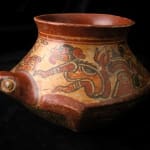Copador Style Mayan Polychrome Frog Effigy Bowl, 300 CE - 900 CE
Painted Terracotta
4.5
PF.6293
Further images
In Mayan mythology, the frog is a powerful symbol of fertility and rebirth, revered for its amphibious nature. The lifecycle of the frog, from aquatic tadpole to terrestrial frog, is...
In Mayan mythology, the frog is a powerful symbol of fertility and rebirth, revered for its amphibious nature. The lifecycle of the frog, from aquatic tadpole to terrestrial frog, is a potent example of an animal’s ability to live in between two worlds. Thus, the choice of a frog to decorate a funerary vessel is quite fitting. For as we watch the tadpole emerge from the water to become a frog, so our spirits shall emerge from our bodies upon death and journey into the realm of the afterlife. In this way, the frog acts as a guide, ensuring fertility and success in the afterworld. Stylistically, the shape of the frog has been adapted to the form of the vessel. The creature’s head, with bulging wide-open eyes, projects from the side of the bowl, as do the legs bent at right angles. On the opposite end, the tail emerges like a mirror image of the head. The area around the frog has been decorated by a series of black spots, no doubt imitating the pattern of the frog’s skin. However, the space along the lower side between the frog’s legs has been decorated by the depiction of a crouching canine beast, complete with spiny back and lapping tongue. This image is repeated on the upper decorative band along the vessel’s shoulder. Here, a seated shaman figure holds his hand outwards to the same canine creature. Is this his pet dog? Perhaps some mythological apparition? What is the relation between the frog and the canine imagery? Found in a tomb, buried along side a fallen ruler or dignitary, this vessel was as important in the afterlife as it was in this world.







